Learn how to make a perfectly buttery, flaky pie crust from scratch using this in-depth tutorial and video. This page includes all of my best success tips, lots of step-by-step photos, and a thoroughly detailed recipe. Millions of readers have been using this helpful guide since 2015. Become a pro with this crust recipe and the rest will be as easy as… eating salted caramel apple pie!
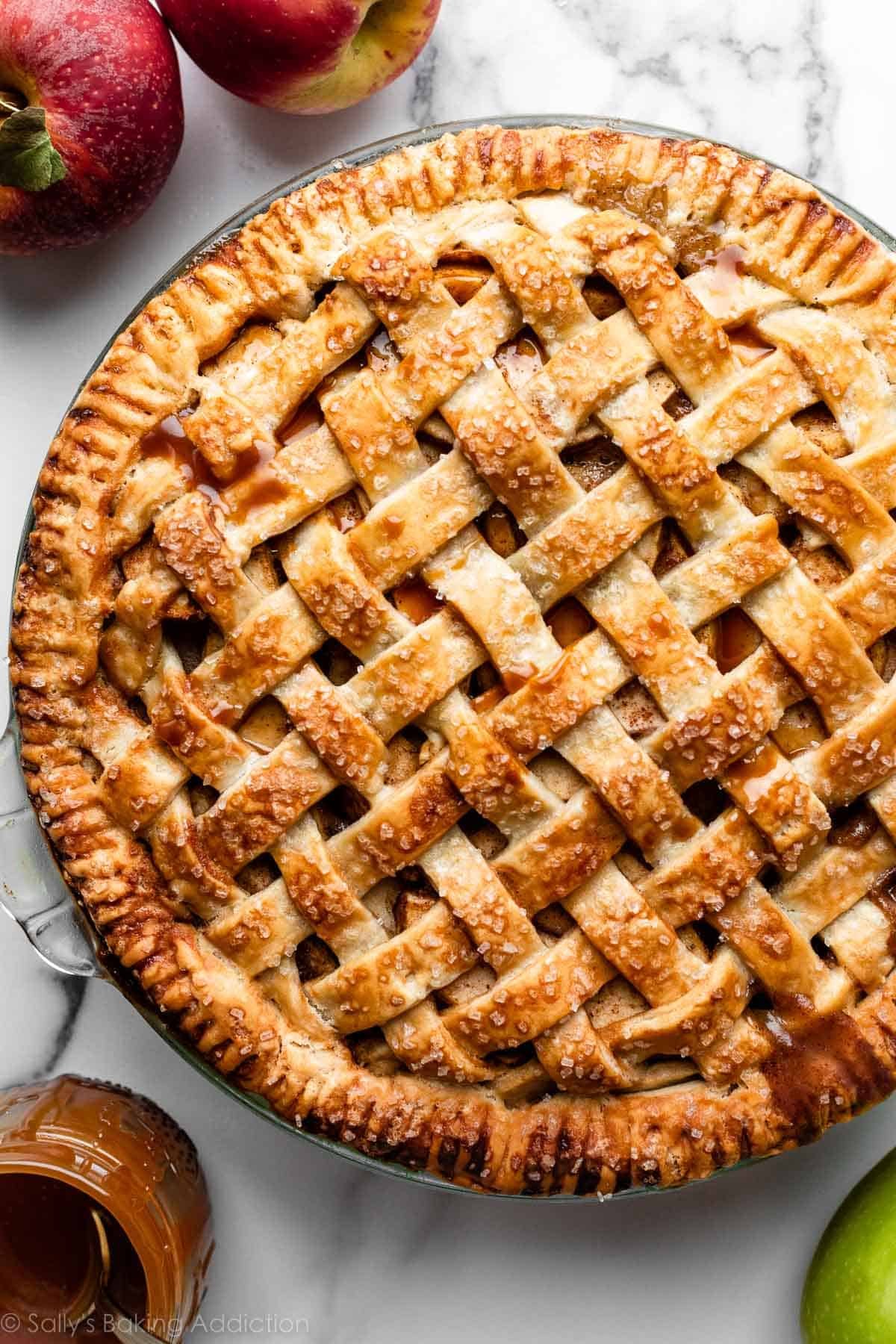
For a baker, there’s nothing more satisfying than making a pie completely from scratch. Pies are often made for special occasions, and there’s a good reason for that: they’re time consuming. This shouldn’t scare you! It should intrigue you. If you’ve ever felt intimidated about making homemade pie crust, I’m here to walk you through it and cheer you on. If I can do this, you can do this.
Pie crust is the foundation for so many delicious desserts (plus savory pies and quiche), so once you build up your confidence in making a crust, you’re opening a door to an entire baking category. And that’s exciting! Whether your favorite pie filling is apple pie or creamy banana cream pie, or even eggs & cheese, the success of the overall pie can really hinge on the quality of the crust.
You wouldn’t hang a beautiful piece of art or favorite photo in a terrible frame, right?
Today I’m teaching you everything about making a buttery, flaky pie crust. This is my absolute favorite pie crust recipe and one of the most popular recipes on this website.
With all the recipe testing that goes into publishing the many pie recipes on this website and in my cookbooks, plus my annual Pie Week, it’s not an understatement to say that I have made a LOT of pies. Along the way, I’ve learned what works and what doesn’t, and I’m happy to share it all with you.
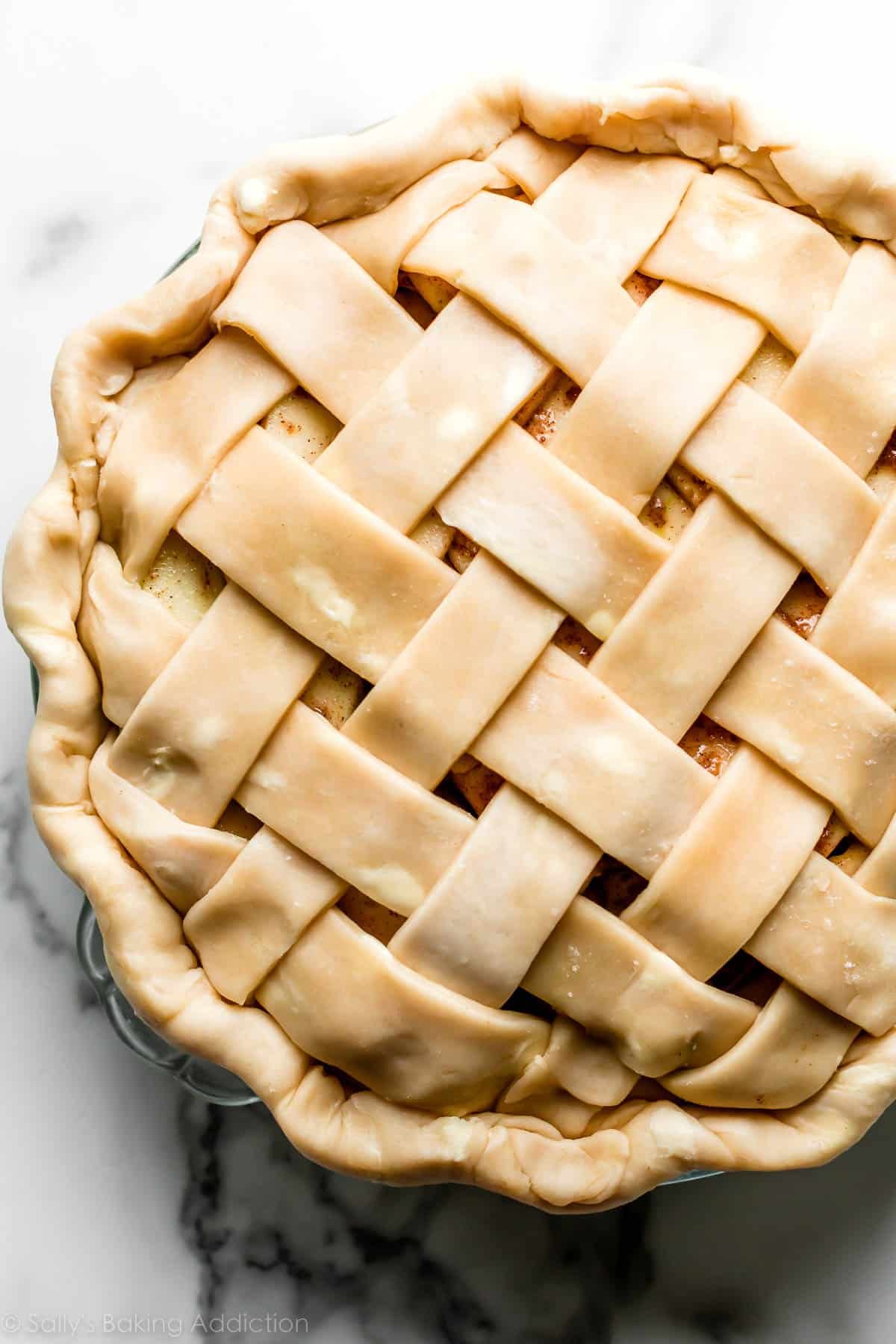
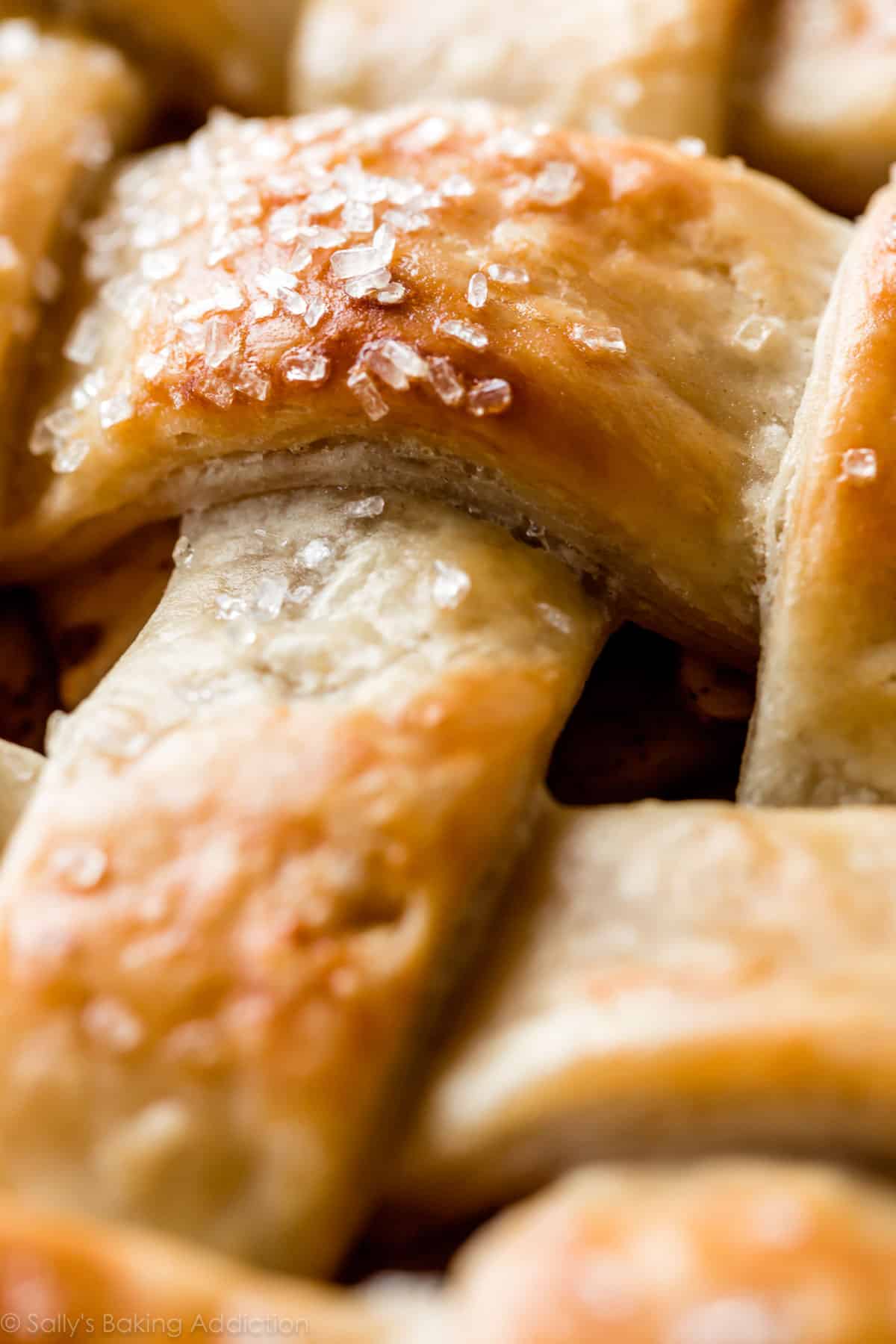
Start With These 5 Ingredients
The ingredient list for pie crust is short & simple:
- Flour: Start with quality flour. Did you know that not all all-purpose flours are equal? King Arthur Unbleached All-Purpose Flour is my go-to for not only pie crust, but for everything. (Not working with the brand, just a true fan!) Why? Its high protein level: “At 11.7% protein, it tops ordinary American all-purpose flours by nearly 2 percentage points.” What does this mean? Baked goods rise higher and stay fresh longer.
- Salt: Enhances the flavor.
- Butter: For that unparalleled buttery flavor and flaky layers.
- Vegetable Shortening: For structure and stability. More on this below.
- Ice water: Liquid brings the dough together. Some recipes call for half water and half vodka, because alcohol doesn’t promote gluten formation, which helps the crust stay flaky and tender. Basically, it’s a gift to anyone who accidentally overworks dough. If you want to try using vodka, use 1/4 cup (60ml) each cold vodka and cold water in this recipe.
You can use this pie dough for so many recipes beyond a traditional pie, too, such as mini pecan pies, mini fruit galettes, apple hand pies, and homemade brown sugar cinnamon pop tarts.
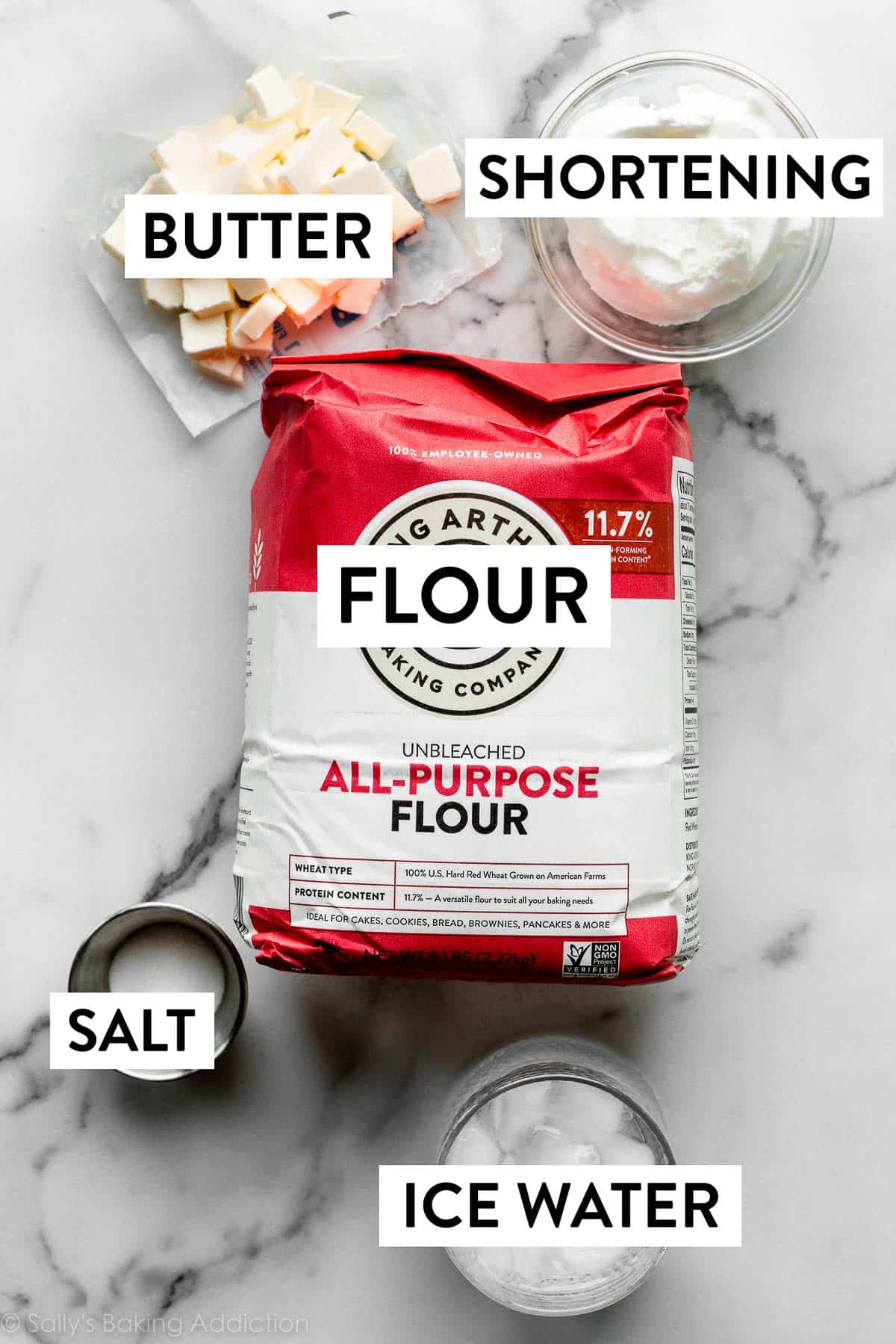
Is Pie Crust Better With Butter or Shortening?
I use BOTH shortening and butter in this pie crust because they work together to make the BEST crust. Buttery, flaky, and tender: the pie-fect trifecta.
- What does butter do? Butter adds flavor and flakiness.
- What does shortening do? Shortening helps the dough stay pliable, which is helpful when you’re rolling and shaping it. Plus, shortening’s high melting point helps the crust stay tender and maintain its shape as it bakes. Have you ever had a butter pie crust lose its shape completely? Shortening is “shape insurance.” 😉
If you don’t want to use shortening, try this all-butter pie crust instead. Let’s compare:
- Using all butter creates a lighter-textured crust and this is due to the butter’s water content. As the crust bakes, the butter’s water converts to steam, lifting up the dough and creating flaky layers. But because of all this butter, the crust doesn’t usually have a perfectly neat-edge/shape compared to the shortening and butter combination.
Both crusts taste buttery and flaky. But overall, this butter-and-shortening crust wins in terms of texture and flavor; AND, if you follow the pie crust recipe carefully, it holds shape too.
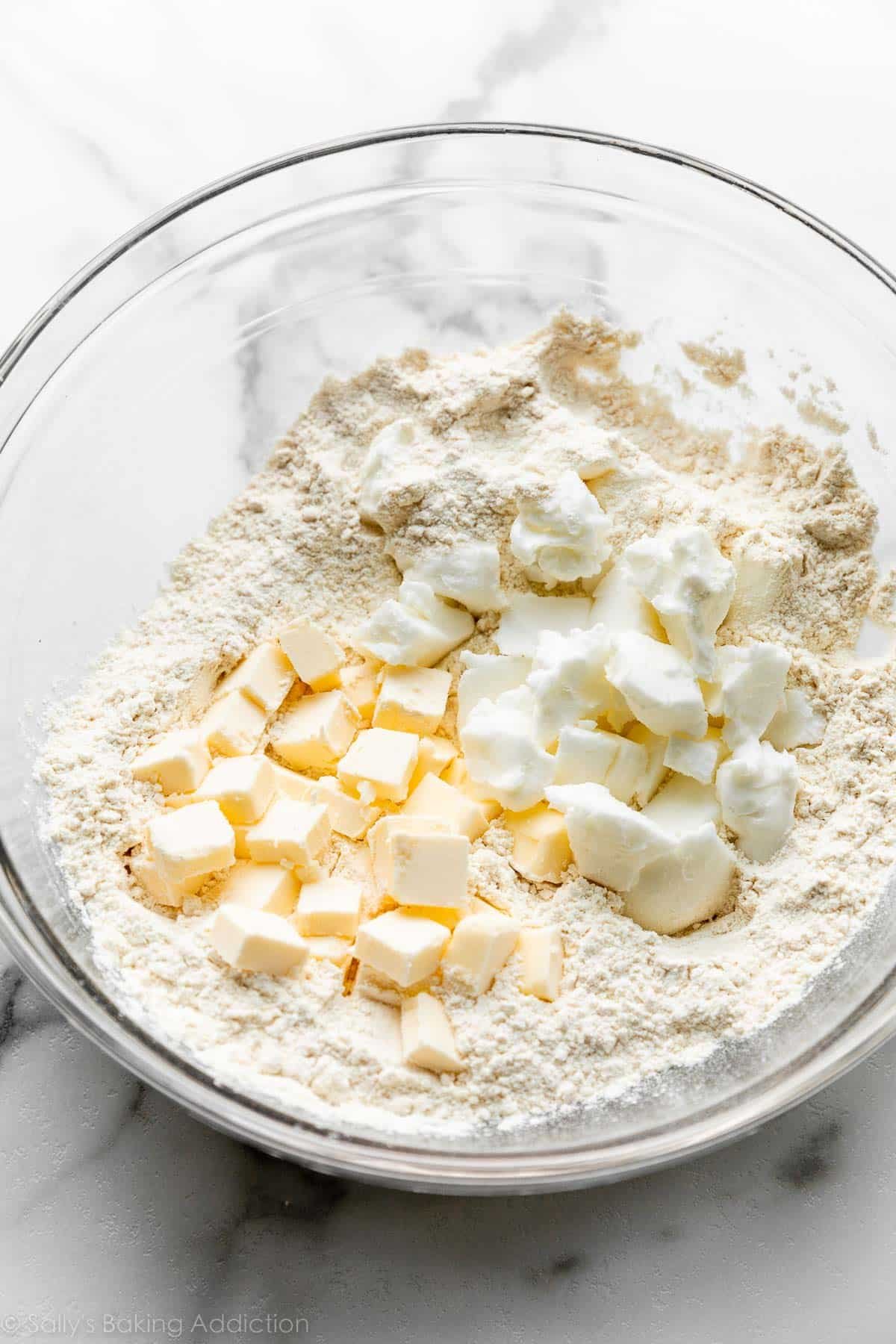
The Secret to Perfect Pie Crust: COLD
The refrigerator is as important as the oven when you’re making a homemade pie.
Why the emphasis on temperature? Keeping your pie dough as cold as possible helps prevent the fats from melting before the crust hits the hot oven. If the butter melts inside the dough before baking, you lose the flakiness. When the lumps of fat melt in the oven as the pie bakes, their steam helps to separate the crust into multiple flaky layers, as explained above. Warm fats will yield a hard, crunchy, greasy crust instead of a tender, flaky crust.
The colder the ingredients, the easier your pie crust is to work with, and the better it will turn out.
Two Tricks to Start as Cold as Possible:
- I keep some of my butter in the freezer and transfer it to the refrigerator a few hours before beginning the crust. This way it is still a little bit frozen and very, very cold. Simply keep the shortening in the refrigerator.
- Mix the dry ingredients together in a large bowl (the flour and salt). Place the bowl in the refrigerator or freezer while you get the rest of the ingredients ready.
These Step-By-Step Photos Will Help
Take the butter and shortening out of the refrigerator. Cube the cold butter and measure out the cold shortening. Give the shortening a little chop—this is actually optional because, truly, the shortening is quite soft even when cold so it’s easy to mix in.
Now it’s time to combine everything. Add the butter and shortening to the dry ingredients, and use a pastry cutter (or 2 forks) to cut in the fats. Some pie crust recipes use a food processor for this, but I don’t recommend it, because it can lead to overworking the fats into the dough, cutting them up too small—which means you’ll need less water and your dough will fall apart. In this step, you’re only breaking up the cold fat into tiny little flour-coated pieces; you’re not completely incorporating it:
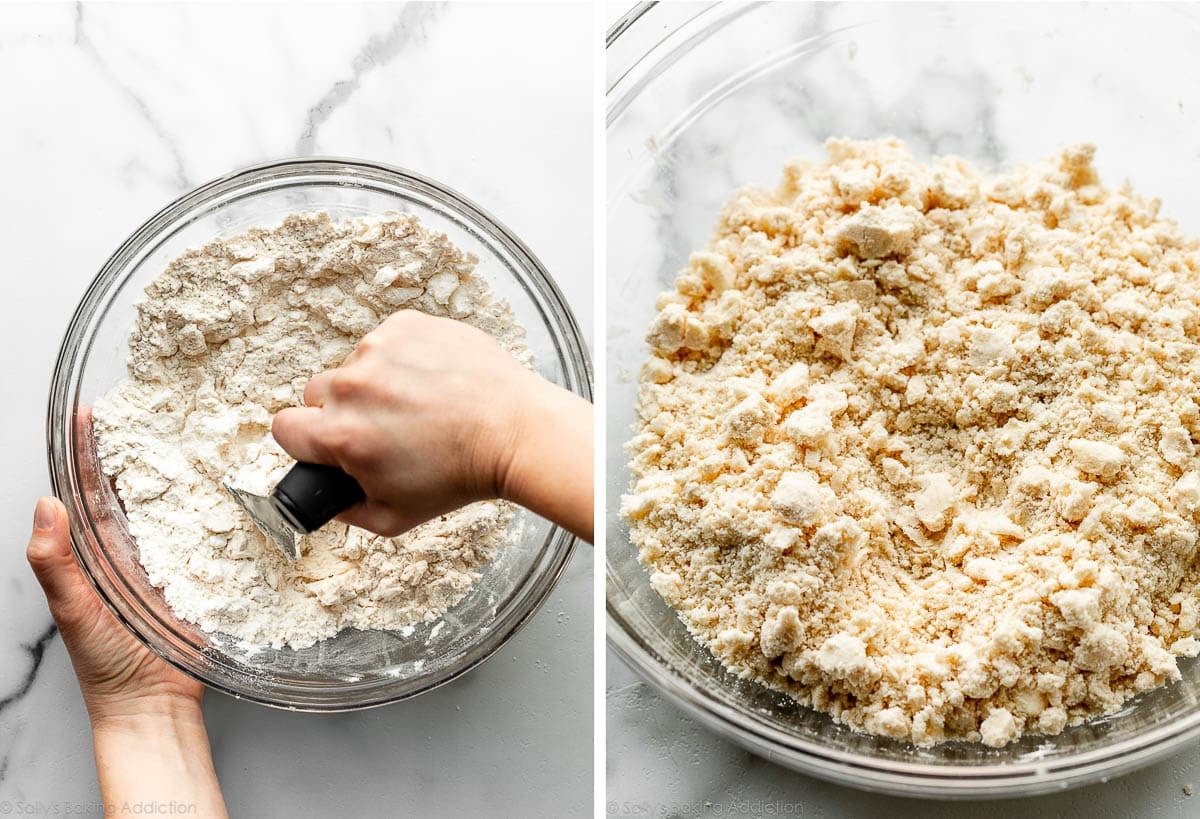
Cut in the fats until the mixture resembles coarse meal—crumbly with lots of lumps, as you see above. You should still have some larger pieces of butter and shortening when you’re done.
From a cup of ice water, measure out 1/2 cup (120ml), since the ice has melted a bit. Drizzle the cold water into the dough 1 Tablespoon (15ml) at a time, stirring after every Tablespoon has been added.
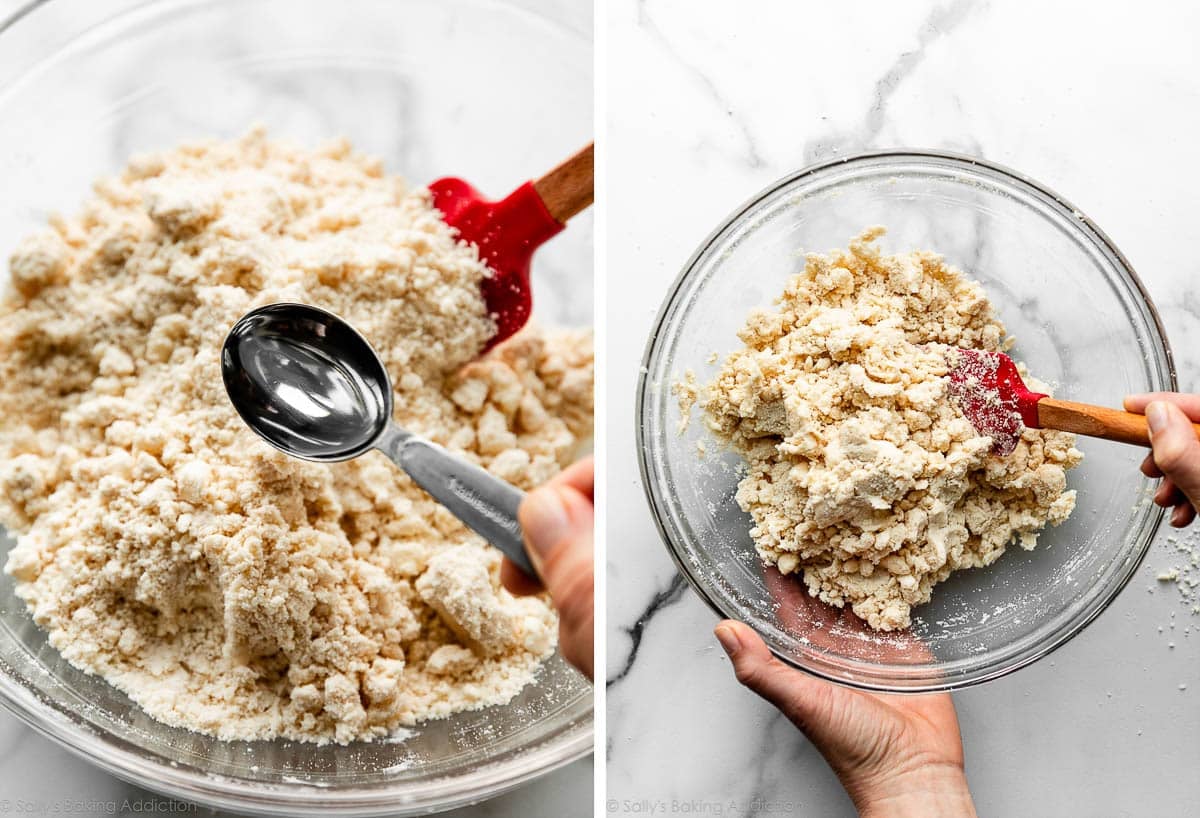
You’ll add just a little water at a time so that you don’t accidentally add too much. Stop adding water when the dough begins to form large clumps. I usually use 1/2 cup (120ml) of water, but if the weather is humid, you may not need as much, and if the weather is really dry, you may need a little more.
If too much water is added, the pie dough will require more flour and become tough.
If too little water is added, you’ll notice the dough is dry and crumbly when you try to roll it out and handle it.
You want the dough to clump together, but not feel overly sticky. Once the dough is clumping together, transfer the dough to a floured work surface.
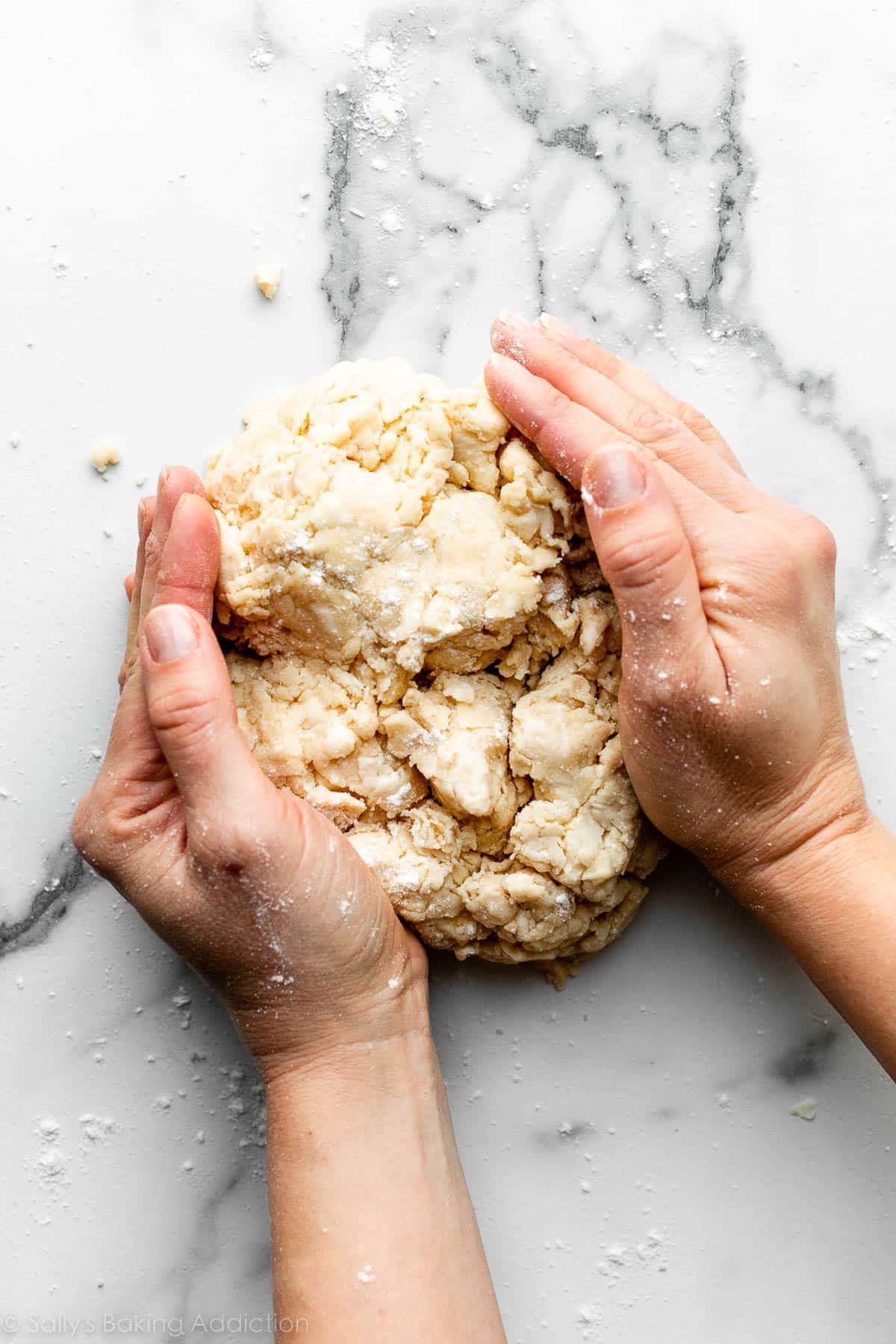
Using floured hands, fold and smush (yes, that’s the technical term) the dough into itself, forming the dough into a ball. Your hands are your best tool, just like when making homemade puff pastry.
The ball of dough should come together easily. If it feels a bit too dry or crumbly, dip your fingers in the ice water and then continue forming the dough with your hands. If it feels too sticky, sprinkle on more flour and then continue forming the dough with your hands.
Once your ball of pie dough has come together, use a sharp knife to cut it in half:
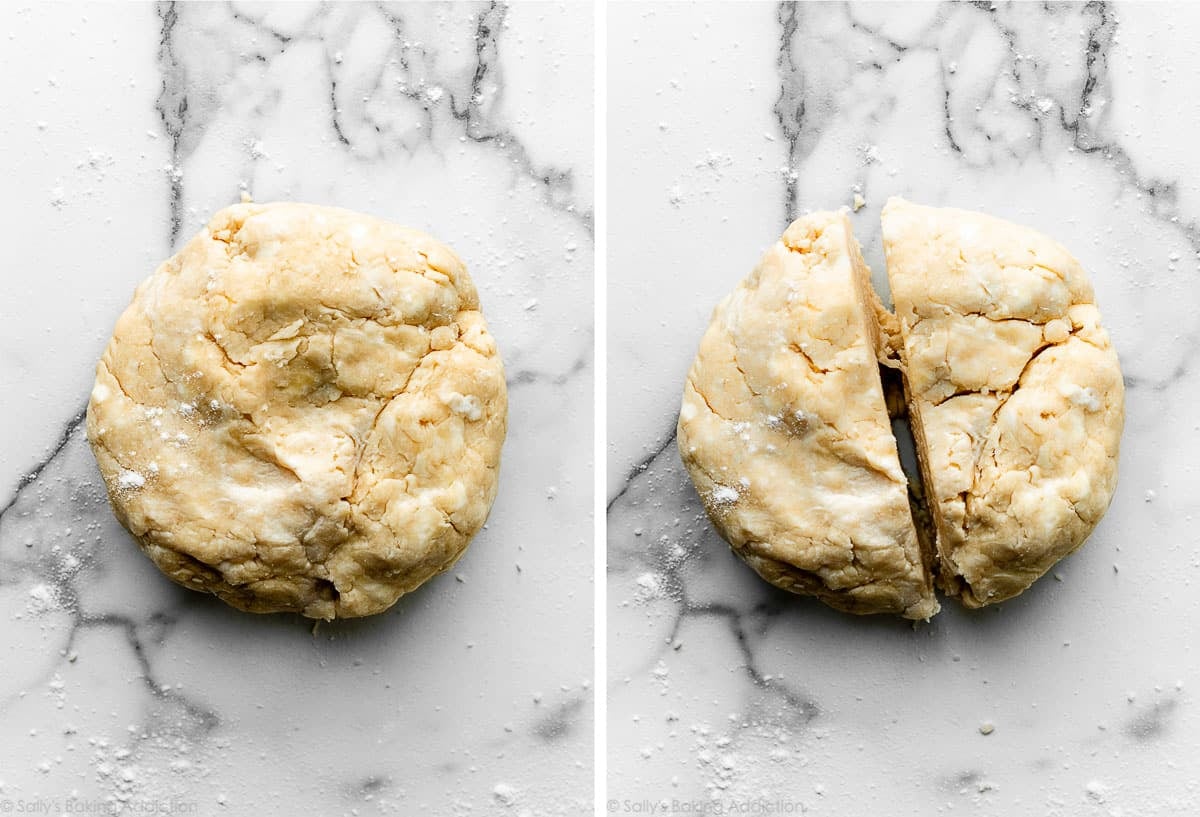
This is enough dough for 2 pie crusts. You can use both crusts for a double-crust pie, like chicken pot pie and strawberry rhubarb pie; or, if your pie doesn’t require a top crust, like coconut cream pie, brownie pie, and lemon meringue pie, save the second pie crust for another pie. You can also roll out the second dough and use cookie cutters to make an easy pie design, like on this pumpkin pie.
Success Tip: Visible Specks and Swirls of Fat in Pie Dough
Take a look at the inside of the dough where you just sliced it. You want to see pieces of butter and flaky layers throughout the pie dough. These specks and swirls of butter and shortening will help ensure a flaky pie dough. They are a GOOD thing!
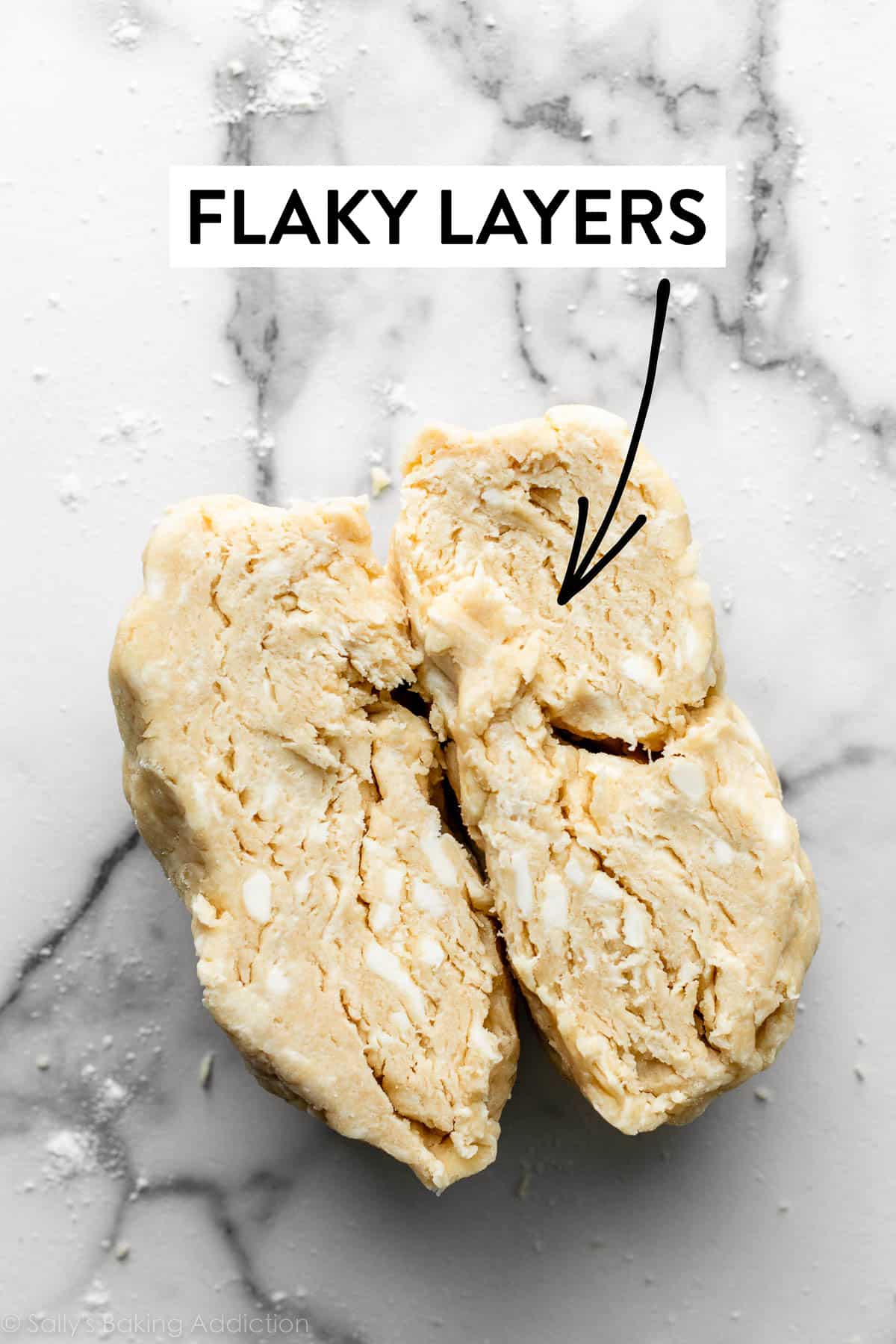
Now your pie dough is ready for a rest in the refrigerator. Flatten each half into 1-inch-thick discs using your hands. The disc shape makes it easier to roll out. Wrap each disc tightly in plastic wrap.
Refrigerate for at least 2 hours or up to 5 days.

Can I Freeze Pie Dough?
Yes, absolutely, and I encourage it! Pie crust freezes beautifully, so it’s a great thing to make ahead of time. Store the tightly wrapped discs of pie dough in the freezer for up to 3 months.
If you know you’re going to want several pies around the holidays, or when your favorite fruit will be in season (cherry pie, anyone?), you can cut down on the amount of time it takes to make pies from scratch the day you want them by making several pie crusts in advance and freezing them.
Thaw the pie crust dough overnight in the refrigerator before rolling it out. It will be extra cold, which is a great starting point.
How to Roll Out Pie Crust
After the dough has chilled for at least 2 hours, you can roll it out. Work with one crust at a time, keeping the other in the refrigerator until you’re ready to roll it out. You’ll need a clean work surface, a rolling pin, and some flour. Lightly flour the work surface, rolling pin, and your hands, and sprinkle a little flour on top of the dough. Use gentle-medium force with your rolling pin on the dough—don’t press down too hard on the dough; you’re not mad at it!
When rolling dough out, start from the center and work your way out in all directions, turning the dough with your hands as you go:
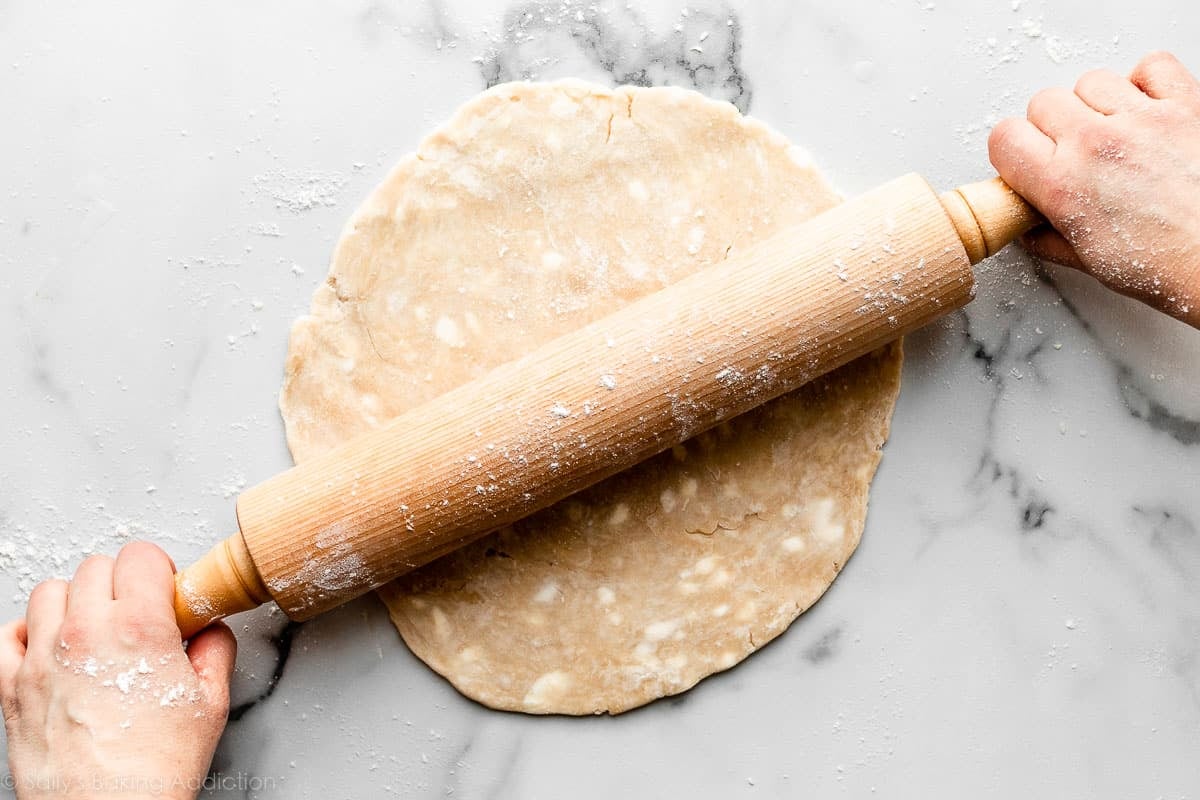
Between passes of the rolling pin, rotate the pie crust and even flip it, to make sure it’s not sticking to your work surface. Sprinkle on a little more flour if it’s sticking. Roll, turn. Roll, turn.
Do you see that beautiful marbling of the butter and shortening throughout the dough? Flaky layers, here you come!
Success Tip: If you notice the dough becoming a lopsided circle as you’re rolling it out, put down the rolling pin and use your hands to help mold the dough back into an even circle:
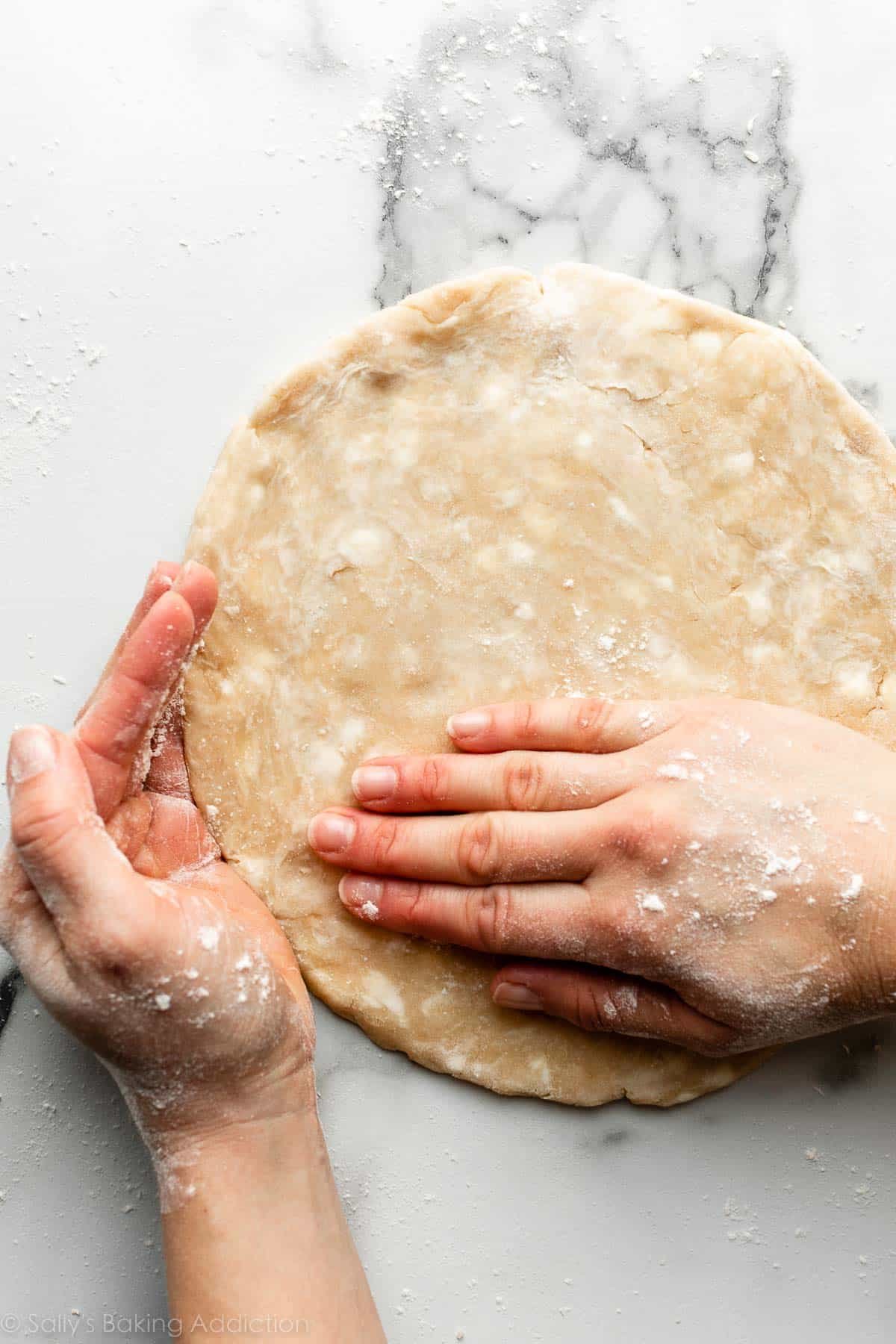
Roll the dough into a thin 12-inch circle, which is the perfect size to fit a 9-inch pie dish. You want enough crust to have some overhang so you can make a decorative edge for your pie.
Your pie dough will be about 1/8-inch thick, which is quite thin.
Success Tip: Since your dough is so thin, use your rolling pin to help transfer the pie crust to the pie dish. Carefully roll one end of the circle of dough gently onto the rolling pin, rolling it back towards you, slowly peeling it off the work surface as you go. Pick it up, and carefully roll it back out over the top of the pie dish. It’s helpful to watch how I do it in the video below.
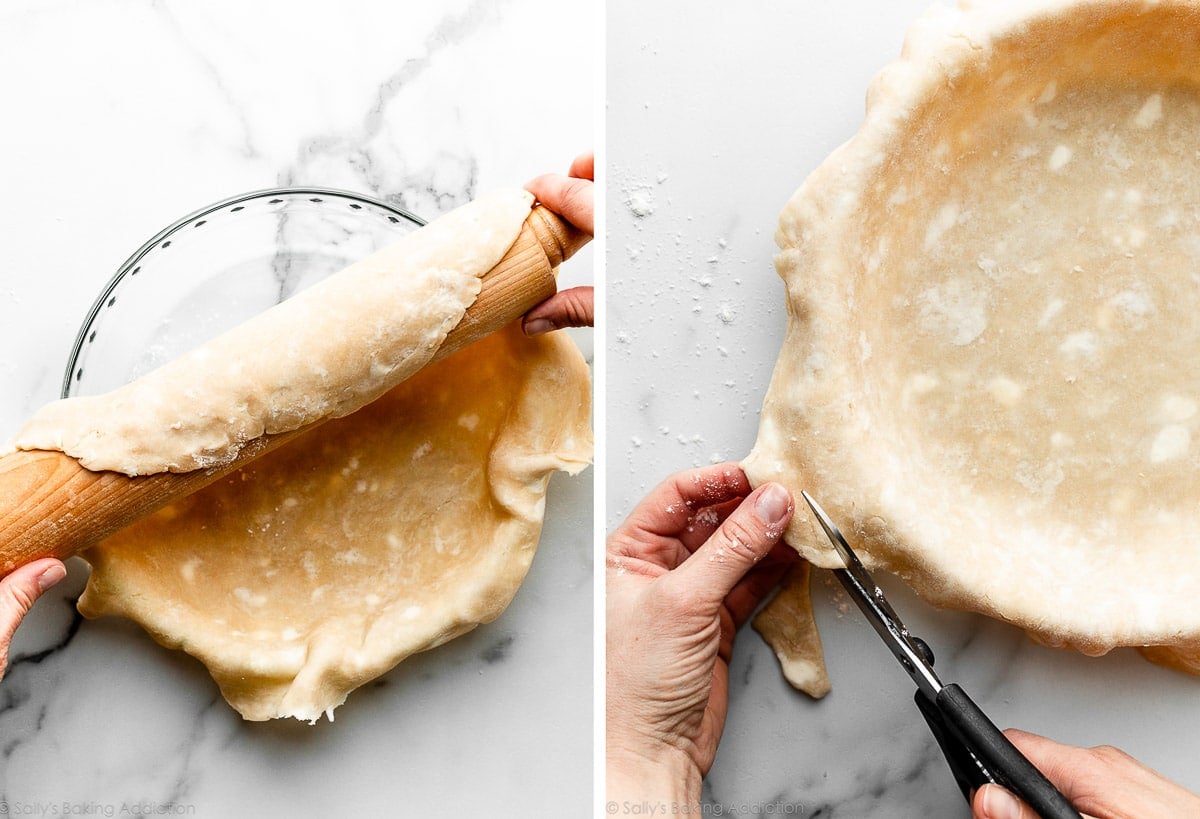
Make sure the pie crust is pretty well centered in the dish, with some overhang all around the sides. Tuck the crust into the pie dish, gently pressing it to the interior all the way around—no air bubbles.
Trim dough around the edges if there’s excess dough in some spots—you want about 1-inch overhang. After you add your pie filling and top crust (such as a lattice pie crust), fold overhang back over and pinch the top and bottom crusts together. Now you can create a pretty edge, such as fluting or crimping. I have a full tutorial on how to crimp and flute pie crust, but here’s a quick overview:
Fluting with fingers: To flute the edges, use a knuckle and 2 fingers to press around the edges of the pie crust, to give it a beautiful and classic scalloped look, like this apple pie.
Crimping with fork: You can also use a fork to crimp the edges, like I do with this peach pie.
Again, review my how to crimp and flute pie crust page and video if you need a little extra help with this step.
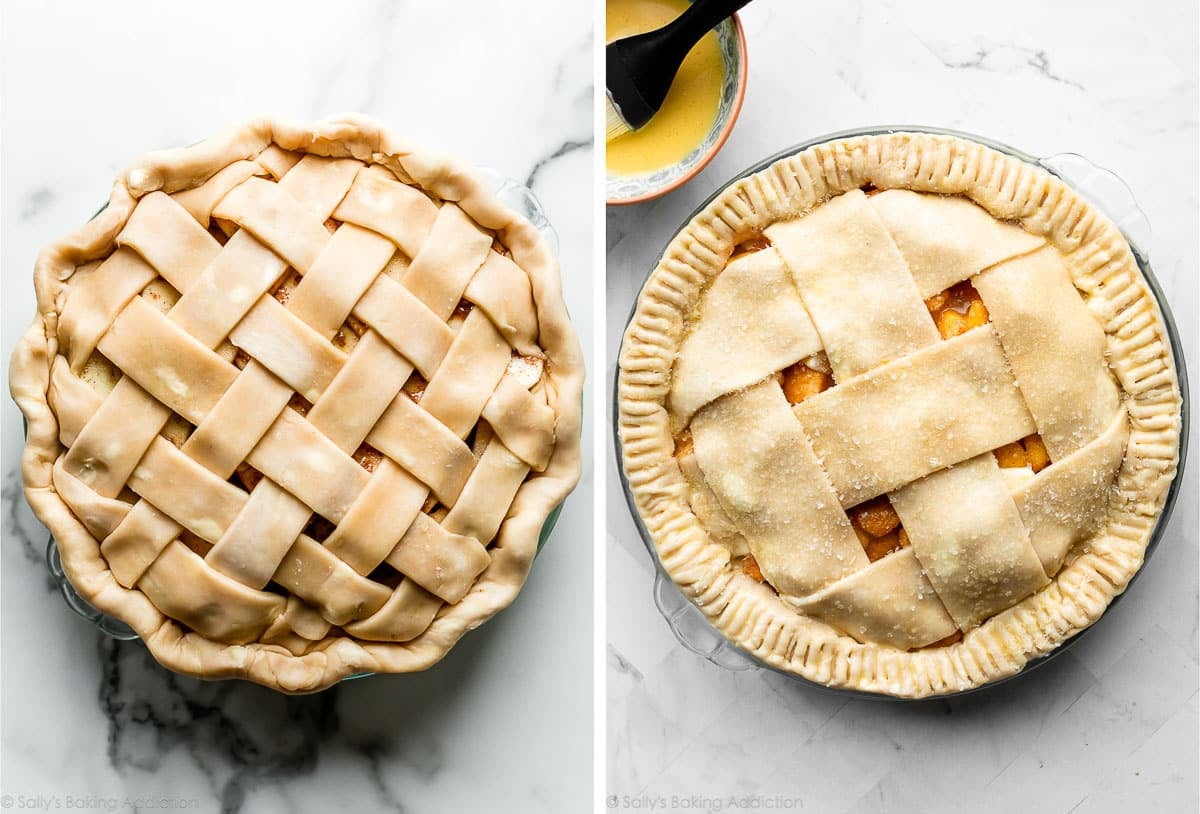
Your pie crust is ready to bake! Follow your pie recipe’s instructions from here; some recipes may call for a fully baked crust, and some may call for a partially baked (par-baked or blind baked) crust. You can read a tutorial on that here in this How to Par-Bake Pie Crust post. And some recipes, like this blueberry pie, don’t require baking the crust at all before adding the filling, because the pie bakes for so long; just spoon/pour the filling right in.
Your pie recipe might call for an egg wash on the dough and for that, use a pastry brush. And if you bake a lot of pies, this list of 10 best pie baking tools will be helpful for you.
Troubleshooting Pie Crust
- Pie crust is tough: Tough crusts are the result of not enough fat in the crust, as well as overworking the dough. Use the recipe below (plenty of fat) and avoid handling the dough more than you need.
- Don’t have enough pie dough: This recipe yields 2 pie crusts. To ensure you have enough pie dough for overhang and a pretty topping, roll your dough out to a 12-inch circle, about 1/8 inch thick.
- Pie crust shrinks down the sides of the dish when baking: This can happen when par-baking a pie crust. See section below.
- Pie dough is dry & cracking around edges when rolling: Use enough ice water when preparing the pie dough. If you work the fats into the dry ingredients too much, the dough will feel too wet before you can add enough water. (And the dough will be dry and thirsty.) Do not overwork the fats in the dry ingredients—you still want those nice crumbles. If it’s too late and you notice the edges of your pie crust are cracking as you roll it out, dip your fingers in ice-cold water and meld the edges back together. Wait a minute, and then try rolling out again.
- Pie dough is falling apart & crumbling when rolling: The dough is likely crumbling because there’s too much fat, and not enough flour and water. Again, this is usually a result of fat being worked in too much, which can easily happen if the ingredients weren’t cold enough. (Refrigerate those dry ingredients before you start!) If it’s too late and the pie dough is crumbling as you roll it out, try adding more water AND more flour. Sprinkle a tiny bit of ice water and flour onto the cracks and crumbled pieces, and gently work it all in with your fingers. Wait a minute, and then try rolling out again.
Gently work ice water drops and flour into your crumbly pie dough to bring it back together:
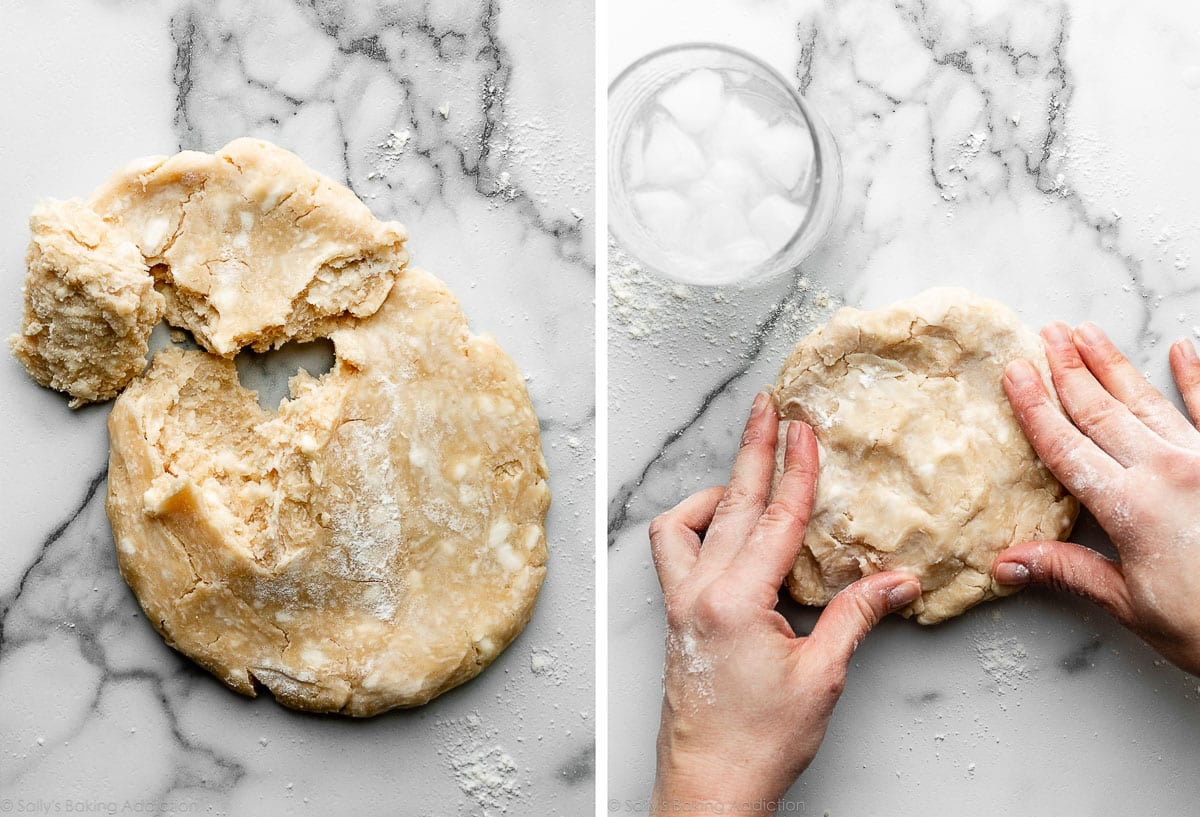
Blind Baking Pie Crust
If your pie recipe requires a fully baked or par-baked pie crust before adding the filling, follow the directions and success tips in this How to Par-Bake Pie Crust guide. You need 2 packs of pie weights, which are metal or ceramic beads that serve to weigh down the crust to prevent the puffing/shrinking. You could use dried beans instead. Whichever you choose, be sure to line the crust with parchment paper, then fill the empty pie crust shell with the weights prior to baking. Without pie weights, the dough will puff up, and then shrink down the sides.
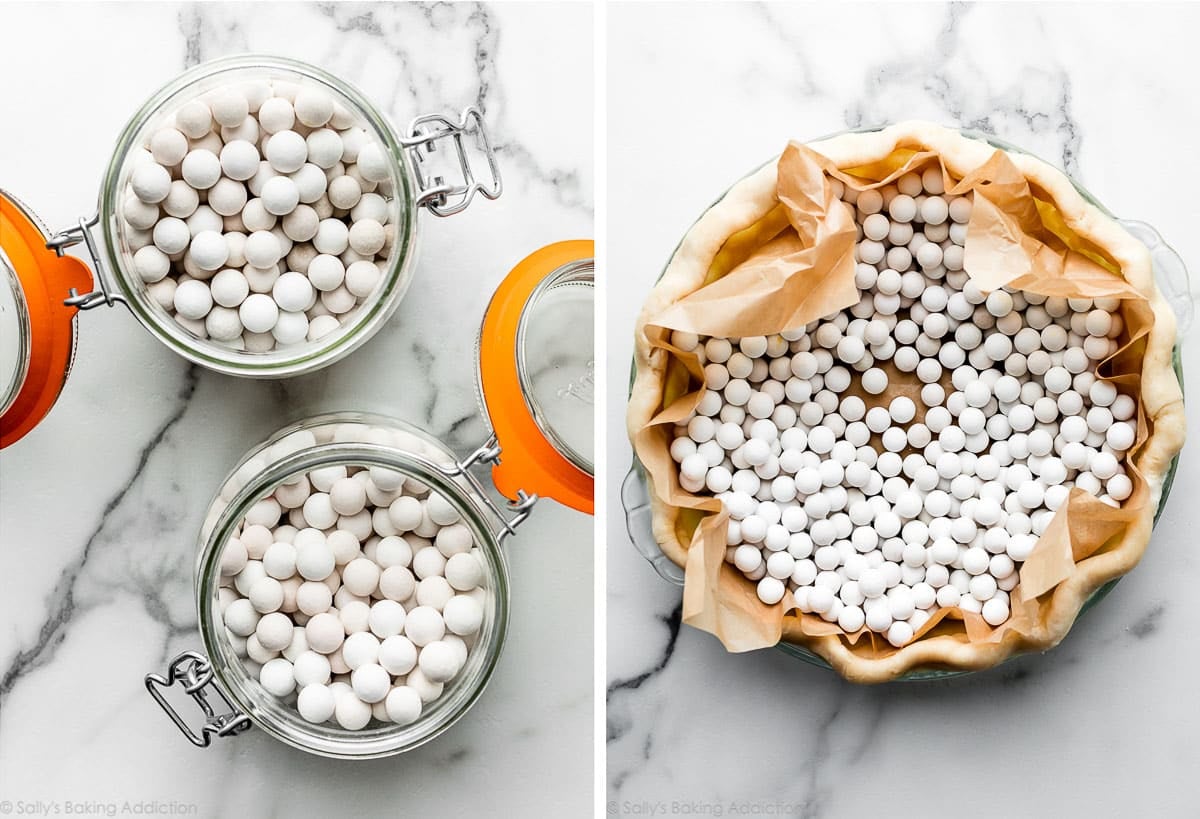
Pie Crust Success Tips
- Use a glass pie dish. I prefer using a glass pie dish when I make pie. Why? Glass dishes conduct heat evenly, which allows the bottom of the crust to bake thoroughly. Also, you’ll be able to see when the sides and bottom of the crust have browned.
- The refrigerator is pie dough’s best friend. Keep everything cold every step of the way: ingredients, the bowl, and the dough before rolling. When taking the pie crust out of the refrigerator to roll out and fill, make sure your pie filling is ready to go. If not, keep the pie crust in the refrigerator until it is.
- Keep dough cold when rolling out: Warm pie dough is unworkable. If the dough becomes too warm when you’re rolling it out, stop what you’re doing, pick it up as gently as you can, put it on a plate or small baking sheet, and then cover and refrigerate it for 10–20 minutes.
- Protect the crust edges from burning: Use a pie crust shield to prevent the edges from burning. A shield keeps the crust edge covered, but the center of the pie exposed, protecting the edges. I usually just make a pie shield out of a piece of aluminum foil. Take a piece of aluminum foil and fold it in half. Cut out a half circle. When you open it back up, you’ll have a square of foil with a circle cut out of the center. If you notice the edges of your pie crust are browning before the pie has fully baked, carefully and gently place the foil over the top of the pie, centering the cut-out hole over the pie. Carefully (obviously it’s very hot!) and lightly tuck the sides of the foil around the pie crust edges, then let the pie finish baking.
- Create a beautiful topping: For designing the top crust, see How to Lattice Pie Crust, How to Braid Pie Crust, or these Pie Crust Designs. And here is my tutorial on How to Crimp and Flute Pie Crust, too.
For more pie crust inspiration, see my graham cracker crust and homemade chocolate pop tarts (with a chocolate crust!).
Print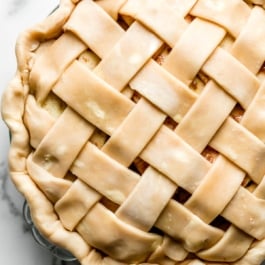
Homemade Buttery Flaky Pie Crust Recipe
- Prep Time: 15 minutes
- Cook Time: 0 minutes
- Total Time: 2 hours, 15 minutes
- Yield: 2 pie crusts (1 lb, 8 ounces dough total)
- Category: Pie
- Method: Baking
- Cuisine: American
Description
This recipe is enough for a double crust pie. If you only need 1 crust for your pie, freeze the other half per the Freezing Instructions below. Is your pie dough tearing, cracking, or crumbling as you try to roll it out? See recipe Notes.
Ingredients
- 2 and 1/2 cups (315g) all-purpose flour (spooned & leveled), plus more for shaping and rolling
- 1 teaspoon salt
- 6 Tablespoons (85g) unsalted butter, chilled and cubed
- 2/3 cup (130g) vegetable shortening, chilled
- 1/2 cup (120ml) ice cold water
Instructions
- Whisk the flour and salt together in a large bowl.
- Add the butter and shortening. Using a pastry cutter or two forks, cut the butter and shortening into the mixture until it resembles coarse meal (pea-sized bits with a few larger bits of fat is OK). In this step, you’re only breaking up the cold fat into tiny little flour-coated pieces; you’re not completely incorporating it. Do not overwork the ingredients.
- Measure 1/2 cup (120ml) of water in a cup. Add ice. Stir it around. From that, measure 1/2 cup (120ml) of water, since the ice has melted a bit. Drizzle the cold water in, 1 Tablespoon (15ml) at a time, and stir with a rubber spatula or wooden spoon after every Tablespoon has been added. Stop adding water when the dough begins to form large clumps. I always use about 1/2 cup of water, and need a little more in dry winter months. Do not add any more water than you need.
- Transfer the pie dough to a floured work surface. Using floured hands, fold the dough into itself until the flour is fully incorporated into the fats. The dough should come together easily and should not feel overly sticky. Avoid overworking the dough. If it feels a bit too dry or crumbly, dip your fingers in the ice water and then continue bringing dough together with your hands. If it feels too sticky, sprinkle on more flour and then continue bringing dough together with your hands. Form it into a ball. Use a sharp knife to cut it in half. If it’s helpful, you should have about 1 lb, 8 ounces dough total (about 680g). Gently flatten each half into 1-inch-thick discs using your hands.
- Wrap each tightly in plastic wrap. Refrigerate for at least 2 hours and up to 5 days.
- After the dough has chilled for at least 2 hours, you can roll it out. Work with one crust at a time, keeping the other in the refrigerator until you’re ready to roll it out. Lightly flour the work surface, rolling pin, and your hands, and sprinkle a little flour on top of the dough. Use gentle-medium force with your rolling pin on the dough—don’t press down too hard on the dough; you’re not mad at it! When rolling dough out, start from the center and work your way out in all directions, turning the dough with your hands as you go. Between passes of the rolling pin, rotate the pie crust and even flip it, to make sure it’s not sticking to your work surface. Sprinkle on a little more flour if it’s sticking; don’t be afraid to use a little more flour. If you notice the dough becoming a lopsided circle as you’re rolling it out, put down the rolling pin and use your hands to help mold the dough back into an even circle. Roll the dough into a very thin 12-inch circle, which is the perfect size to fit a 9-inch pie dish. Your pie dough will be about 1/8 inch thick, which is quite thin. Visible specks of butter and fat in the dough are perfectly normal and expected.
- Because your dough is so thin, use your rolling pin to help transfer the pie crust to the pie dish. Carefully roll one end of the circle of dough gently onto the rolling pin, rolling it back towards you, slowly peeling it off the work surface as you go. Pick it up, and carefully roll it back out over the top of the pie dish. It’s helpful to watch how I do it in the video below.
- Proceed with the pie per your recipe’s instructions. If your dough requires par-baking, see helpful How to Par-Bake Pie Crust tutorial.
Notes
- Make Ahead & Freezing Instructions: Prepare the pie dough through step 5 and freeze the discs for up to 3 months. Thaw overnight in the refrigerator before using in your pie recipe.
- Special Tools (affiliate links): Large Glass Mixing Bowl | Pastry Cutter | Rolling Pin | For more tools you may need to completely assemble and bake your pie, see my 10 Best Pie Baking Tools list.
- Salt: Use regular table salt. If using kosher salt, use 1 and 1/4 teaspoons.
- Shortening: This recipe uses a butter and shortening combination. Butter for flakiness and flavor, and shortening for its high melting point and ability to help the crust hold shape. You can use butter-flavor shortening if desired. If you want to skip the shortening, feel free to try this all-butter pie crust instead. Some readers have substituted lard for shortening in this recipe with success.
- Can I use a food processor? You can use a food processor to bring the dough ingredients together in step 1, but I find it quickly overworks the dough. For best results and a light, flaky crust, I recommend a pastry cutter.
- Pie dough is dry & cracking around edges when rolling: Use enough ice water when preparing the pie dough. If you work the fats into the dry ingredients too much, the dough will feel too wet before you can add enough water. (And the dough will be dry and thirsty.) Do not overwork the fats in the dry ingredients—you still want those nice crumbles. If it’s too late and you notice the edges of your pie crust are cracking as you roll it out, dip your fingers in ice-cold water and meld the edges back together. Wait a minute, and then try rolling out again.
- Pie dough is falling apart & crumbling when rolling: The dough is likely crumbling because there’s too much fat, and not enough flour and water. Again, this is usually a result of fat being worked in too much, which can easily happen if the ingredients weren’t cold enough. (Refrigerate those dry ingredients before you start!) If it’s too late and the pie dough is crumbling as you roll it out, try adding more water AND more flour. Sprinkle a tiny bit of ice water and flour onto the cracks and crumbled pieces, and gently work it all in with your fingers. Wait a minute, and then try rolling out again.
- More Crusts: If you need more than 2 pie crusts, make another separate batch of dough. Doubling or tripling the recipe leads to over- or under-working the dough, which ruins all of your efforts.



















Tried this recipe twice today. What am I doing wrong!!?? Very frustrated. The first time, the walls of the pie caved in while par baking. Even with the extra strips!! The second time, it was a soupy goopy mess in the bowl and I tossed the whole thing out. I hadn’t even added a quarter cup of water yet!!
Hi Sandra! Make sure to use enough pie weights when par-baking, you want to mostly fill the crust to prevent shrinking. As for as a gooey mixture, make sure to keep your fats (butter and shortening) VERY cold to prevent them from melting into the dough while you work with it. Hope these tips help for next time! The video in the post above may be helpful as well for a visual.
This is my go-to recipe now for no-fail pie crust. Also, for those considering using lard: My friend and I experimented last year, making crusts with one recipe as written here and one with lard instead of vegetable shortening. They both turned out well and tasted delicious, but our families all agreed that the crust made with lard had a slight taste and flake advantage!
I’ve been using a food processor with your recipe but it seems the dough comes out extremely wet and sticky, even with just a tiny bit of water. I tried dumping the flour/shortening/butter mixture into a bowl and adding the water there but it still was very wet with just 2 tblsp of water. But after chilling it, it was very dry and brittle when I tried to roll it out, and kept breaking, even the strips for the lattice crust. Suggestions?
Hi Kirk, While you could use a food processor to make this pie crust, it’s strongly recommend to use a pastry cutter, or even two forks, to avoid over-mixing. Food processors are quick to over-work pie dough which is likely the root of these troubles. For next time, we recommend trying one of these alternate methods instead of the food processor. Let us know if we can help to troubleshoot further!
Love, love the pie dough recipe ,(as well the site). Have received many compliments and requests for the recipe, evenfrom a cousin whose mom was the pie queen in our family – well earned. I changed the recipe just a bit. Grated 1 stick (8 T) frozen butter into the flour before adding
butter flavired shortening and lightly toss. Then add shortening. Also, if you have any leftover pie dough, roll out, smear with butter and top with cinnamon sugar. Cook’s treat.
Hi, I want to try out this recipe but can’t find any shortening. Is it possible to replace it with margarine (higher water content)?
Thanks 🙂
Hi Rachel, if you’re unable to find shortening, we recommend using this all butter pie crust instead.
Could you substitute butter and/or shortening with high ratio shortening? Could you use high ratio shortening with butter? Lastly, what is your opinion about using the high fat butter like Kerry Gold or is that just too much fat?
So many questions. Thanks!
Hi Marsha, European style butter, like Kerry Gold, is wonderful in cooking but we find it’s difficult to use in baking recipes– especially pie crust. Its higher fat percentage, while making the butter tasty, creates too much grease in doughs. We have not tested a high ratio shortening but suspect that the same would be true if using it.
I want to make your Blueberry Pie for a friend who is vegan. Should I use butter-flavored shortening for the pie crust and how much?
Hi Glenda! You can use all shortening but your pie crust will not be as flaky.
Just found this recipe and will pair it with the updated blueberry pie recipe. I am wondering about changing the baking time if I use small pie pans that are the size of mini tarts. Would I shorten the bake time?
Thanks! Your baking addiction really is helpful to me!
Hi Connie! Yes, the bake time will be shorter for smaller pies, though we’re unsure of the exact bake time needed. Thank you so much for making and trusting our recipes!
Hi Sally, you’re my favorite baking site! Love your stuff! Quick question, I made these crusts for several pies and the dough turned out weird. It was simultaneously both very, very sticky and falling apart which made it difficult to work and a real chore to finally get into a pie pan, taking several attempts. However, the taste and consistency of the crust turned out great once baked. I’ve made a lot of different crusts and have never seen this before. Where did I mess this up?? Thanks!
Hi Ridlon! If the dough was sticky, it may have had too much liquid added – try adding a bit less next time. And make sure to use flour when rolling it out and handling it to prevent it from sticking and breaking apart. Glad you enjoyed it once it was baked!
Sally I’ve taken a break from making pies …like a ton of pies during quarantine now that I’ve returned to work. But hubby brought home rhubarb to encourage me to make one, so I did. This time I used my vitamix to blend (pulse) all the pie ingredients. I was worried because I barely used any water towards the end thinking the crust would be too moist. It turned out great!! Now there’s a quicker way to make your excellent crust whenever we crave pies (I see this happening often this summer). Thank you again!
Can I make the crust in my food processor?
Hi Michelle, While you could use a food processor to make this pie crust, it’s strongly recommend to use a pastry cutter, or even two forks, to avoid over-mixing. Food processors are quick to over-work pie dough.
Thank you! After years of hit and miss pie crusts, I now have consistent success using your recipe and methods. I had come to the conclusion that I just could not make a good pie crust, and my “pie crust stress” was getting the best of me. Then, I found your website and everything changed. Your tutorial video felt like you were talking to me. I appreciated the information regarding how to incorporate the flour and butter and what “small peas” actually looked like, as well as approximately how long it took to achieve the consistency. I smiled and felt such relief when you demonstrated how to correct imperfections, especially when rolling out the crust and positioning it into the plate. I loved your technique of cutting an extra strip of dough for evening out the edges. Now, I have complete confidence and success when making your Homemade Buttery Flaky Pie Crust. I have been following this recipe and tips for two years now, and I have shared your website with many of my friends. In closing, I have learned a great deal from you. I want to thank you for helping me to be better at baking and easing the stress of pie crusts. Now, I am always proud to serve my pies to my guests and family. No more pie crust stress! Bless you.
Thank you so much for your kind note, Lisa! We’re so thrilled to hear that you’re enjoying our recipes and love this pie crust recipe, it’s a favorite. Happy baking!
Can I replace the vegetable shortening with something else if I don’t have any on hand?
Hi Jennyfer, if you don’t have vegetable shortening available, we recommend using our all-butter pie crust instead!
Hi there! good to replace vodka with other tipples? such as whisky or Gin?
Hi Audrey! Best to stick with cold water or vodka for this pie crust.
I know lard has been around since the beginning of time and produces a tasty crust, but why would anyone want to put that my bad cholesterol in their body?
I was disappointed in this crust as it did not really brown in the blind bake despite following the directions exactly. Even with increased baking time I did not get a nicely browned crust…. then I remembered that my other pie crust recipes have a teaspoonful of sugar. I think this recipe would benefit greatly from that addition. The sugar is NOT for sweetening but greatly enhances proper browning.
I love this recipe! Pie crust has been a real challenge for me, hard to work with, lackluster taste or texture and just a pain. The recipe and tips are solid and my husband who doesn’t eat the top edge of the crust, ate every crumb of this. Since she mentioned lard in some of the comments I made this again, substituting lard for the vegetable shortening and keeping all other ingredients and the methods the same. The results were awesome. This is my only pie crust recipe now, just as written or subbing out the vegetable shortening for lard.
Thanks so much for the super quick reply! Happy Easter to you and your team!
Hello! Quick question, would this yield enough dough for a deeper pie dish. Looking to make a quiche, but would love the quiche to be a little taller than the traditional glass dishe. Thanks!
Hello! This recipe yields two crusts. For an extra deep crust, you can use 1 and a half of the dough disks to roll out a larger dough (or use as much dough as you need).
I enjoyed this recipe so much! My husband is not a fan of pie crust. I used the shortening and butter and vodka in the crust. He loved it! One thing I did do because of the emphasis you used on keeping everything cold is I froze the vodka and put a glass of water in the refrigerator, refrigerated overnight. I also, cut in the shortening and butter to the flour and then refrigerated overnight too. The next day I started where I left off and used the 1/4c of vodka and 1/4c of water. Making sure to keep everything cold.
It made the best pie crust because I didn’t let anything get room temperature. It was definitely cold to touch though when I was rolling it out. Worth it though. Thank you!!
We’re so glad you enjoyed this crust recipe, Lacinda!
I gift pies on holidays for family and friends. I wanted to know if you are supposed to refrigerate pies or if they should sit at room temperature!! Thanks
Hi Tori, it really depends on what type of pie you’re making. We refrigerate most of our pies, but not all!
I didn’t realize you have to thaw overnight in the fridge and was hoping to bake the crust today. Are there any shortcuts or do I have to postpone until tomorrow? Thanks!
Hi Michelle! You can thaw it in the refrigerator or at room temperature. The refrigerator is best. It takes a few hours to completely thaw out!
Excited to try this recipe. May I use a food processor to make the dough?
Hi Jane! While you could use a food processor to make this pie crust, it’s strongly recommend to use a pastry cutter, or even two forks, to avoid over-mixing. Food processors are quick to over-work pie dough.
I usually love your recipes, Sally, but unfortunately, this pie crust missed the mark for me. Normally, I go for an all-butter crust because I despise the taste of shortening, specifically, Crisco. Also, I’m a vegetarian, so lard is not an option. I wanted to change things up and experiment with a new crust recipe, so I came here and found that Sally was singing the praises of part butter/part shortening pie crusts. I figured that she knew what she was talking about. Now, the texture of the pie was phenomenal- flaky, crusty, tender and not at all soggy (I made an apple pie). However, the flavor was bitter and the shortening overwhelmed the taste of the butter. Am I missing something?? I used good quality shortening (Star brand sunflower oil shortening), so I’m at a loss. Am I using the wrong vegetable shortening? Perhaps I should just stick with my all-butter crust after all.
Hi Mallory, Thank you for trying this recipe. We are not familiar with that brand of shortening but if the texture was right you likely didn’t do anything wrong. It’s possible that it was the flavor from that particular shortening as sunflower oil can have a bitter taste. If you decide to try again we usually use Crisco brand or similar, or you can stick with our All Butter Pie Crust.
I made this recipe for the first time. I made a double batch and two single batches. The single batches turned out well. The double batch not so well. I may have not added enough liquid. The double batch was so dry it kept falling apart. I couldn’t use it for a pie crust, however, I could make a bunch of hand pies. The crust was so flaky. I’m going to try the recipe again.
I thought in the past I saw instructions for making pie crust in a stand mixer. I was wondering if Sally has instructions for making pie crust in a stand mixer?
Thanks!
Hi Donna, while you could use a food processor (we don’t suggest using a stand mixer) to make this pie crust, it’s strongly recommend to use a pastry cutter, or even two forks, to avoid over-mixing. Food processors are quick to over-work pie dough.
Can you use coconut oil in place of shortening??
Hi Kristi, some readers have substituted solid and cold coconut oil. However, you may enjoy our all butter pie crust instead.
The crust came out very good. A couple of questions though. First, when I tried to roll it out, it kept sticking to the roller. I had to use a ton of flower to get it close to the 12” circle I was shooting for. Any tips? Second, can you add chicken fat in place of something else in this recipe?
Hi Mike, using flour to prevent the crust from sticking when rolling out is totally fine! You may find you need to use less as you practice more. We’ve never tested chicken fat in this recipe so can’t offer any advice there.
This is the most delicious flaky pie crust I’ve ever made. Going to be a staple from now on in my kitchen! Thank you!
Hello!
I am a Sally’s diehard and everything I have ever made from this site has tasted phenomenal. The explanations are always helpful and spot-on as well.
However, I never get enough for two crusts from this recipe. It’s always way too thin and barely reaches the top of the pie plate. If I make two crusts, both pies inevitably leak. My quiche is pooling in the oven right now. What am I doing wrong? It’s seems like enough for 1.5 pie crusts?
I genuinely feel it must be something I am doing because I see no other reviews about this.
I don’t use deep dish plates, they are standard 9 inch glass pie plates.
I roll it out between 1/8 and 1/4 inch thickness.
I weigh my ingredients:
King Arthur all purpose flour
I use a local butter that’s highly reviewed (Kate’s Butter)
Crisco
Kosher salt
The suggestion 50:50 water vodka mixture
Any idea where I am falling short here?
Hi Nina, somehow we missed this comment but hopefully it will still be helpful. I do wonder if your crusts are too thick. I can roll half of this dough out to a fairly large circle (slightly beyond 12 inches) and it’s still thick enough for the bottom crust of a pie. Try rolling out to 1/8 inch thickness next time instead of between 1/8 and 1/4 thickness. It sounds like the preparation of this dough is correct, it may just be the thickness that needs tweaking.
Hi,
Can this be used for a veggie pot pie?
Hi Anne, Absolutely. If using a regular pie dish, one batch of this crust will make enough for a top and bottom crust. We do not par-bake the crust in our Chicken Pot Pie recipe.